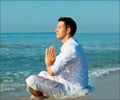Guided yoga is more effective than conventional treatment for preventing fainting in repeat sufferers.

‘Guided yoga is found to be more effective than conventional treatment for preventing fainting in repeat sufferers. This may aid in treating patients with non-invasive measures for their fainting events.’





Approximately half of the general population experience at least one syncopal event during their lifetime. Preventions like keeping hydrated, avoiding hot crowded environments, tensing the muscles, and lying down are recommended for it. However, only modest benefits have been reported with these methods. "Repeated fainting gives rise to mental stress, anxiety, depression, and a constant dread of the next episode. Quality of life is negatively affected due to the unpredictability. Besides, some countries do not allow patients to drive," says study author Professor Jayaprakash Shenthar of the Sri Jayadeva Institute of Cardiovascular Sciences and Research, Bangalore, India.
Yoga Helps overcome Fainting Events
The present study was the first to examine guided yoga as a treatment for 100 patients with a mean age of 33 years (more than half were women) with at least 3 episodes in the previous year. None of the patients were receiving treatment for syncope, and none were practicing yoga at the time of enrolment.
Participants were randomly allocated to the yoga or conventional treatment group. The conventional treatment group was advised to consume 6 to 9 grams of salt and more than 3 liters of water every day and perform physical counterpressure maneuvers such as crossing legs and tensing thigh and buttock muscles when warning signs of syncope occurred.
Advertisement
The number of fainting episodes during follow-up was recorded by the patients. Quality of life was assessed at baseline, 3, 6, and 12 months using the syncope functional status questionnaire. Questions were asked on how syncope affects daily activities such as driving, shopping, exercise, and relationships with family and friends and asked the respondents to rate their fear/worry on a scale of 1 to 8.
Advertisement
"The benefits of guided yoga were apparent as early as three months after treatment initiation and were sustained at six and twelve months. Preliminary evidence suggests that the breathing and meditation aspects of yoga have a positive effect on the autonomic system3 while 'asanas' improve vascular tone - both of which could prevent gravitational pooling of blood in the lower parts of the body. Our small, well-controlled, single-centre study suggests that yoga may be a useful therapeutic option for patients with vasovagal syncope. Larger multicentre studies are needed to confirm the results," says Professor Shenthar.
Source-Medindia














